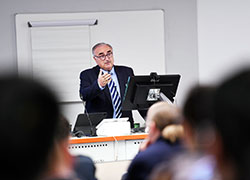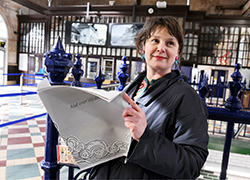Virtual Meeting
It’s not every day you have the opportunity to step into a key role in a piece of classical French literature, but that’s what’s on offer when you meet Professor Marc Cavazza.
His research group has created a virtual reality (VR) environment at the University of Teesside in which not only are key characters from Gustave Flaubert’s 19th-century literary masterpiece Madame Bovary brought to ‘virtual’ life – but you can become one of the leading characters!
It is all down to six years of hard work by a dedicated research team within the University’s School of Computing – Marc and Teesside graduates Fred Charles, Jean-Luc Lugrin and David Pizzi – who are pushing at the frontiers of virtual reality for art and entertainment.
‘We used a commercial game engine as a development environment to support real-time visualisation and created new artificial intelligence components to control virtual actors’, said Professor Cavazza, a world-renowned expert in the new discipline of interactive storytelling whose team will be moving into the new Institute of Digital Innovation.
He described the stage created by the VR system as ‘an immersive interactive storytelling environment’. It has three walls and a floor used as screens, and is operated by a computerised system using dedicated software to support real-time stereoscopic visualisation.
Into this VR CAVE you step, wearing lightweight shutter-glasses to see the full effect, and interact with the virtual characters taken straight from Flaubert’s famous love triangle.
As the adulterous affair between Emma Bovary and Rodolphe develops, you – the user – play the part of Madame Bovary’s lover.
What’s so immersive and interactive is that your responses will determine the outcome of the affair. You can influence the subsequent unfolding of the narrative. You don’t have to follow the original script to the letter. At present only three chapters of Flaubert’s Madame Bovary have been built into the immersive storytelling environment, which Professor Cavazza likens to a Holodeck – familiar to Star Trek fans in which characters entertained themselves in virtual worlds.
‘We’re still at the experimental stage, but we’ve created a small-scale, yet complete, integration of a real-time immersive interactive storytelling system which puts us among the leaders in this field’, says Professor Cavazza.
‘This work has been well received in the scientific community and presented at major international conferences, such as ACM Multimedia’, said Professor Cavazza. ‘We believe it could be the next big thing in interactive TV and digital entertainment. We are currently collaborating on interactive storytelling with both Eidos Interactive and the BBC as part of two externally-funded research projects.’
Professor Cavazza says he deliberately took Flaubert’s tale of illicit love and potential betrayal as the ideal storyline because it is a psychological novel in which relationships between the characters and their feelings play such an important role.
A key factor was that he managed to get hold of the author’s original preparatory work on the novel which gave him greater insight into the characters’ feelings, allowing them to be built into the programme.
‘To reflect that the characters’ behaviours are driven mostly by their psychological states, we use conjunctions of elementary feelings as goals for the emotional planner’, explained Professor Cavazza. ‘This allows new situations to emerge as a result of other characters’ action – including the user.’
Although most action is driven by Emma’s desires, the user’s role will influence the emotional states of the main characters and affect the future storyline. So, if Rodolphe says he plans to leave Emma, this generates a feeling of anger in Emma. She reassesses her situation and gradually removes herself from his influence and pursues future happiness in family life with her husband.
‘We have achieved short interactive storylines of between two to three minutes so far and we know our work is pioneering and has a long way to go', says Professor Cavazza, who is convinced his Teesside team has made significant strides forward.
The VR system was built at a cost of less than £200,000, which Professor Cavazza says is ‘incredibly good value thanks to a close collaboration with our supplier’. Original funding for the installation came from the Higher Education Funding Council for England’s ‘SRIF3’ initiative, from the Institute of Digital Innovation’s ‘concept testing’ fund and from part of a previous research project funded by the European Union.
This work also benefited from wide-ranging collaborations. ‘We worked together with colleagues at the University of Pittsburgh and at the VR Centre of Laval in France to design specific software and hardware components and the project’s visuals were sub-contracted to a graduate business created by former students of the School of Computing who set up 3rd Dimensions Creations Ltd on the campus’, said Professor Cavazza.
 Teesside University hosts groundbreaking hydrogen conference
Teesside University hosts groundbreaking hydrogen conference University supporting development of new £1m concrete plant
University supporting development of new £1m concrete plant Academic’s artwork on display at Middlesbrough station
Academic’s artwork on display at Middlesbrough station